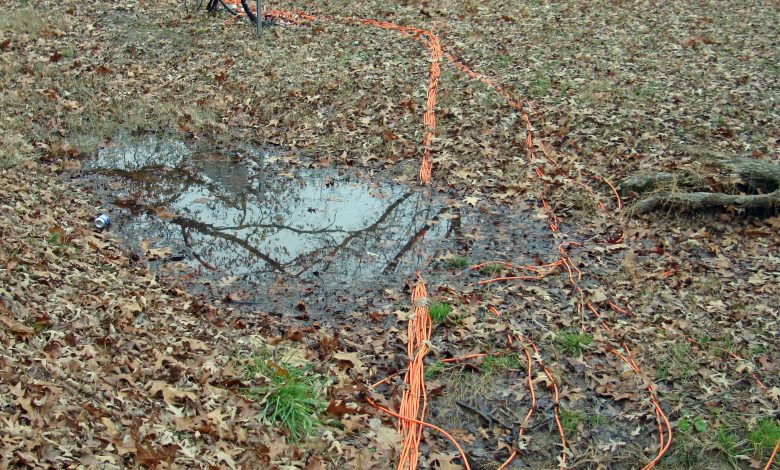GFCIs
A necessary evil in outdoor decorating

We all love to drive around and look at Christmas lights. We compare, critique and gather new ideas (aka: copying someone else’s) while commenting on everyone’s design, but as soon as it rains, what happens? Everything goes dark. What causes it?
A protection we electricians call GFCI (Ground-Fault Circuit Interrupters) is a must for your safety when around a Christmas display. A ground-fault occurs when there is a break in the low-resistance grounding path from a tool or electrical system. The electrical current may then take an alternative path to the ground through the user, resulting in serious injuries or death. The GFCI is a fast acting circuit breaker designed to shut off electric power in as little as 1/40 of a second. It works by comparing the amount of current going to and returning from equipment along the circuit conductors. When the amount going differs from the amount returning by approximately five milliamperes, the GFCI interrupts the current or trips.
The GFCI is designed to trip quickly and prevent an electrical incident. If it is properly installed and maintained, this will happen as soon as the faulty tool is plugged in. If the grounding conductor is not intact or of low-impedance, the GFCI may not trip until a person provides a path. In this case, the person will receive a mild shock, but the GFCI should trip so quickly that no one will be seriously harmed.
As an electrician, I have seen some scary things in Christmas displays over the years. There are those buckets filled with water that have light controllers submerged in them and still plugged into the wall socket. Then there are the electrical wires cut and taped lying in puddles of water or on pool covers. Don’t get me started about the extension cords in roof gutters or the lamp cords buried under the dirt. The question people with these risky installations always ask is “Why does my GFCI keep tripping?”

Unfortunately, the very nature of outdoor Christmas decorations are they’re outdoors and exposed to the weather. Think about all those electrical connections looking for moisture from rain, humidity and snow just so they can end up tripping your GFCI. The good news is with a little extra work; your display can live in harmony with the outdoors and electricity.
There are many types of GFCI protection. You probably have the typical replacement receptacle with a test and reset button that is super easy to trip when it rains. When this type of GFCI is used, a plastic cover has to be installed over the receptacle so the cord that is plugged in doesn’t get damp from the rain. Think about the typical fix for this tripped GFCI. You end up outside in the rain on your hands and knees poking around for that little reset button. Danger Will Robinson!
A better solution is a GFCI breaker installed in your electrical distribution panel. It typically handles multiple receptacles and also has an easily accessible test/reset button. If this GFCI trips, you reset it from inside your house. It’s much better and safer for you.
Outside, around your display, the most important thing you can do to prevent your GFCI from tripping is tape all the male and female cord connections. I recommend using Scotch 33M electrical tape made by 3M ($5 a roll) because even when it’s cold the product remains flexible and waterp
roof. The cheap electrical tape becomes stiff and cracks when the weather gets cold opening a path for water to get into your connections and trip that GFCI.
Make sure there are no open light sockets or female cord ends. Depending on the environment I sometimes recommend buying the child proofing plug covers/inserts that are used on electrical receptacles around the house to keep little fingers away from danger. Outside they can be pushed into the female plug ends of light strings. They’re cheap and readily available in the baby sections of most stores.
Another trick is to anticipate where water will puddle when it rains. By using plastic tent stakes and zip ties I elevate wires about two inches off the ground in these areas. You can even use some green garland to disguise the orange extension cords that are elevated and obvious to your viewers.
When plugging in a series of light sets on a tree, always keep the main connection at least a foot off the ground. Make sure the connection is behind the tree so your audience can’t see it.
I too often see plastic bags stuffed with cord connections and rolled up strings of lights that are still energized. Rain always finds a way inside the bag and there goes your GFCI. To make matters worse, it takes days for the plastic bag to dry out and by that time more rain clouds are on the horizon. Avoid the plastic bags.
Another problem area is where your light controllers are placed outside. Make sure they’re mounted at least a foot off the ground, all cables exit the bottom of the cabinet and the plugs are off the ground.
It’s the little things done correctly that lead to a happy coexistence with GFCIs in your display. Take the time to wire things right and keep you and your family safe all year long.
Who is Steven Pansini? I’m a union electrician at IBEW Local #3 and a general foreman in charge of 15 to 50 men at any given time. I’ve always loved Christmas since being a kid and have been playing with Christmas lights since I was ten. I also love to make animatronic figures.
This article was included in the March 2010 issue of PlanetChristmas Magazine.
By Steve Pansini




